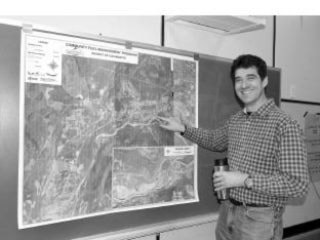A forest fuel management program carried out by District of Clearwater has both reduced the risk to the community of wildfires plus created employment at a critical time, according to Mayor John Harwood.
Speaking at an open house held last Wednesday evening to discuss the program, Harwood said the program has been a collaborative effort that would not have worked without the efforts of many.
He credited corporate administrator Leslie Groulx and councilor Bert Walker for putting together the applications that got the program underway.
“I probably would’ve just gone for a quarter-million but Bert Walker said to go for the full $2.4 million, and we’ve got it over two years,” said the mayor.
Groulx also praised Walker’s efforts in her report to the meeting.
“Bert Walker and Tim Pennell (Wells Gray Country director) said don’t go small, go big,” she said.
The $2.4 million in provincial and federal funding has resulted in 6,830 person-days of employment, Groulx said. That’s the equivalent of about 50 workers for six months.
“Fuel management won’t eliminate the risk of fire but it will change fire behavior,” said Wes Bieber, community wildfire protection coordinator.
Three main techniques are used, he said: reducing crown density by cutting down trees, reducing ladder fuels by pruning and thinning, and reducing fuel loading by disposing of dead trees and accumulated debris on the forest floor.
At first much of the wood collected was chipped and sold to Domtar to make pulp out of. Later, when that proved uneconomic, it was burned.
North Thompson Provincial Park required several fuel treatment prescriptions, Bieber reported.
The most severe treatment was along the access road, where the priority was to make sure people at the riverbank or the camping area would not be trapped at by a fast-moving fire. The least severe was along the river, where both riparian and archeological values needed protection.
Treatment in the camping area was limited to preserve privacy between tenting sites.
Some root rot centers were left untreated. Taking out trees would just encourage more root rot, Bieber said, plus hazelnuts and other deciduous trees - types that are relatively fire resistant, already dominated many of the centers.
Bieber noted that if climate change proceeds as predicted then the present forest fuel reduction program would just be the first step. In any event, the treatments will need to be repeated later as new trees grow in. How long this will take will depend on the individual site, he said.
Local resident Ted Richter was unhappy with the changes made in North Thompson Provincial Park.
“I grew up here but now that park is like a foreign place to me,” he said.
Bieber said there are many unknowns in predicting what the outcomes of the fuel management program will be. He said he had tried to interest Thompson Rivers University in assigning students to do long-term research plots but without success.
Cheryl Thomas asked what effect the program would have on understory plants such as soopolallie. Bieber said the program didn’t touch such plants unless they happened to be under a burn pile. He predicted that opening up the forest would benefit some understory plants, such as huckleberries.
The effect that windstorms might have was Sandra Holmes’ concern.
Bieber replied by saying they had made an effort to leave the most wind-firm trees. His bigger concern was that opening up the canopy might result in more snow-press damage to smaller trees.
“I’m taking the lessons learned here to other communities,” Ministry of Forests fuel management specialist Gord Pratt told the open house. “Keep doing what you’re doing.”
Forest protection officer Jim Jones gave some tips on protecting your home from forest fires. The first priority should be creating a 10 m zone around any building, he said. Brochures with more information are available on-line or at the District of Clearwater office.
How to protect your home from other types of fires was the focus of a presentation by fire chief Mike Smith and firefighter Wayne Wysoski. Every household should have smoke detectors and fire extinguishers, they said.
